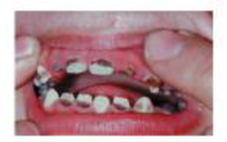
Concept explainers
Culturing Microorganisms
One of Koch’s postulates for demonstrating that a certain agent causes a specific disease requires that microorganisms be isolated and cultivated (Chapter 1). Medical laboratory personnel must also grow pathogens as a step in the diagnosis of many diseases. To cultivate or culture microorganisms, a sample called an inoculum (plural: inocula) is introduced into a collection of
Clinical Case Study Cavities Gone Wild

Five-year-old Daniel appears to be shy. He always looks at the floor, has no friends, never plays with the other children, and will rarely speak to adults. When he does speak, it is difficult to understand his broken enunciation. His skinny frame and the dark circles under his eyes make him appear malnourished. Daniel cries frequently and misses many days of school.
A speech specialist at school finds that only two of Daniel’s teeth are healthy; all the others have rotted away to the gum line. The little guy is in constant pain, and it hurts to chew. A doctor later determines that bacteria from the cavities in his mouth have entered his bloodstream and infected his heart, causing an irregular heartbeat and poor blood circulation.
- 1. How does knowledge of biofilms help explain the bulk of Daniel’s problems?
- 2. What can Daniel, his parents, and health care professionals do to cure his diseases?
- 3. What is the scientific name of the nutrient that Daniel’s parents should eliminate from his diet to help prevent a repeat of this condition?
- 4. A recent study has shown that brushing does more than clean plaque from the teeth; it also disrupts associations between oral bacteria. How does this simple act help prevent the formation of biofilms?
Want to see the full answer?
Check out a sample textbook solution
Chapter 6 Solutions
Microbiology With Diseases By Taxonomy (6th Edition)
- please draw in what the steps are given. Thank you!arrow_forwardplease draw in and fill out the empty slots from image below. thank you!arrow_forwardThere is a species of eagle, which lives in a tropical forest in Brazil. The alula pattern of its wings is determined by a single autosomal gene with four alleles that exhibit an unknown hierarchy of dominance. Genetic testing shows that individuals 1-1, 11-4, 11-7, III-1, and III-4 are each homozygous. How many possible genotypes among checkered eagles in the population?arrow_forward
- students in a science class investiged the conditions under which corn seeds would germinate most successfully. BAsed on the results which of these factors appears most important for successful corn seed germination.arrow_forwardI want to write the given physician orders in the kardex formarrow_forwardAmino Acid Coclow TABle 3' Gly Phe Leu (G) (F) (L) 3- Val (V) Arg (R) Ser (S) Ala (A) Lys (K) CAG G Glu Asp (E) (D) Ser (S) CCCAGUCAGUCAGUCAG 0204 C U A G C Asn (N) G 4 A AGU C GU (5) AC C UGA A G5 C CUGACUGACUGACUGAC Thr (T) Met (M) lle £€ (1) U 4 G Tyr Σε (Y) U Cys (C) C A G Trp (W) 3' U C A Leu בוט His Pro (P) ££ (H) Gin (Q) Arg 흐름 (R) (L) Start Stop 8. Transcription and Translation Practice: (Video 10-1 and 10-2) A. Below is the sense strand of a DNA gene. Using the sense strand, create the antisense DNA strand and label the 5' and 3' ends. B. Use the antisense strand that you create in part A as a template to create the mRNA transcript of the gene and label the 5' and 3' ends. C. Translate the mRNA you produced in part B into the polypeptide sequence making sure to follow all the rules of translation. 5'-AGCATGACTAATAGTTGTTGAGCTGTC-3' (sense strand) 4arrow_forward
 Medical Terminology for Health Professions, Spira...Health & NutritionISBN:9781305634350Author:Ann Ehrlich, Carol L. Schroeder, Laura Ehrlich, Katrina A. SchroederPublisher:Cengage Learning
Medical Terminology for Health Professions, Spira...Health & NutritionISBN:9781305634350Author:Ann Ehrlich, Carol L. Schroeder, Laura Ehrlich, Katrina A. SchroederPublisher:Cengage Learning Biology: The Dynamic Science (MindTap Course List)BiologyISBN:9781305389892Author:Peter J. Russell, Paul E. Hertz, Beverly McMillanPublisher:Cengage Learning
Biology: The Dynamic Science (MindTap Course List)BiologyISBN:9781305389892Author:Peter J. Russell, Paul E. Hertz, Beverly McMillanPublisher:Cengage Learning





